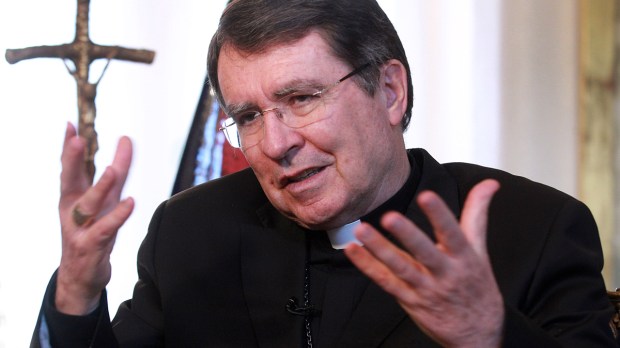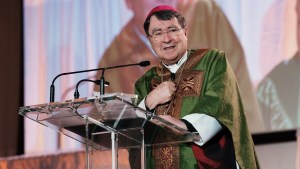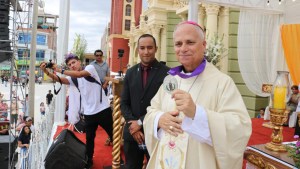He may be old enough to retire — apostolic nuncios can retire at 70 — but Archbishop Christophe Pierre is still on his mission in the prestigious and strategic position of nuncio to the United States. At 77, the native of Rennes (France) is about to receive the cardinal’s biretta, a mark of the Argentine Pontiff’s confidence and esteem.
In 2016, Archbishop Pierre took over in the United States for Archbishop Carlo Maria Viganò, the nuncio who later became a flashpoint of controversy.
Family background
The eldest of six children, Christophe Pierre was born in Rennes on January 30, 1946. He told I.Media that he feels “Breton” although he didn’t spend all of his childhood there. His father, a lawyer and former prisoner of war who made a spectacular escape from an officers’ camp in Austria, chose to emigrate to Madagascar when his son was just three years old. They returned to France after 10 years, then went back to Algeria where his father was a military examining magistrate in Marrakech. They then moved back to the French coastal city of Saint-Malo.
Young Christophe grew up in a family where the Church “was part of the landscape.” His mother was one of the co-founders of Catholic Action in Brittany, and his father founded a Catholic scout troop. Thus, the children were immediately involved in Catholic movements and the apostolate.
“My family was the Church, an open Church,” he says. In this context, his vocation was born “naturally.” After considering religious life, he entered the diocesan seminary at the age of 17.
At the end of his training, his bishop offered him the Holy See’s diplomatic track. However, he was very reluctant, fearing that this path would not be pastoral enough. After ordination to the priesthood in 1970, he first did a master’s degree in theology at the Catholic Institute of Paris. He then served for three years as curate in a parish in the Diocese of Nanterre, where he was influenced by the congregation of the Sons of Charity.
Nuncio to Uganda in 1999
The young priest finally accepted a place at the Pontifical Ecclesiastical Academy, the “school for nuncios” in Rome. He studied there for four years, and then completed a doctorate in canon law at the Pontifical Lateran University.
Archbishop Christophe Pierre, who has never been posted to Rome, began his diplomatic service with the Holy See in 1977. He was assigned to a number of nunciatures — in New Zealand, Mozambique, Zimbabwe, Cuba, Brazil, and at the UN in Geneva — before being appointed Apostolic Nuncio to Haiti by John Paul II in 1995. Cardinal Angelo Sodano, then Secretary of State, consecrated him bishop on September 24, 1995, in Saint-Malo.
Four years later, in 1999, the archbishop was appointed nuncio to Uganda. In 2006, Archbishop Pierre was one of the favorites to take up the post of secretary for Relations with States of the Vatican Secretariat of State. Another Frenchman, Archbishop Dominique Mamberti — a cardinal today — was eventually appointed.
Then, in March 2007, Benedict XVI appointed him nuncio to Mexico. In Mexico City, the diplomat organized the trips of Benedict XVI (2012) and then Francis (2016). On May 30, 2016, he was awarded the Mexican Order of the Aztec Eagle by the Mexican government.
In 2013, Archbishop Christophe Pierre’s name was also circulating among the possible Secretaries of State being considered for Pope Francis.
Nuncio to the United States in a period of turmoil
On April 12, 2016, Pope Francis appointed him apostolic nuncio to the United States of America. This was a delicate position, since his predecessor from 2011 to 2016 had become such a controversial figure.
Archbishop Viganò’s name is linked to the first Vati-Leaks scandal of 2012. Letters he had written to Benedict XVI about Vatican corruption leaked to the press. Then in 2018, the Italian prelate published a testimony accusing Pope Francis of having made the then Cardinal Theodore McCarrick, Archbishop Emeritus of Washington, a “trusted advisor” in episcopal appointments in the United States — this, despite the nuncio’s assurances that he had informed the Pontiff of the cardinal’s inappropriate behavior towards seminarians and the sanctions against him.
This situation eventually culminated in McCarrick’s resignation from the College of Cardinals and his loss of clerical status. It also led to another rare event: in 2020, the Holy See published in full the report of its investigation into the mechanisms that led to the cover-up of these abuses, including at the highest levels of the hierarchy. During these years following those revelations, Archbishop Christophe Pierre faced a Church in the United States in turmoil.
Peace, unity, and synodality
In a country where Catholics can be torn between “progressives” and “conservatives,” the French nuncio has often urged bishops to work for unity. Recently, he encouraged them to implement the synodality promoted by Pope Francis. This is a theme that Archbishop Christophe Pierre defends, denouncing the tendency to “fight over ideas.”
In July 2023, Archbishop Pierre accompanied Cardinal Matteo Zuppi, sent by the Pope on a peace mission to Washington — after stops in Kiev and Moscow. He took part in a two-hour meeting with President Joe Biden.
A pastor wherever he goes
In all, Archbishop Pierre has lived in nine countries, often for long periods. He’s a happy nuncio who describes himself as an “ordinary guy” and who has made his mission a very pastoral commitment. “I’m in constant contact with people, with human situations,” he says. He believes that “you’re a pastor because you want to be, wherever you are.”
The list of new cardinals created by Francis includes one of Christophe Pierre’s compatriots, François Bustillo, Bishop of Ajaccio. With them, France now has six cardinal electors: Cardinal Aveline, Archbishop of Marseille; Cardinal Mamberti, Prefect of the Supreme Tribunal of the Apostolic Signatura; Cardinal Philippe Barbarin, Archbishop Emeritus of Lyon; and Cardinal Jean-Pierre Ricard, Archbishop Emeritus of Bordeaux.



